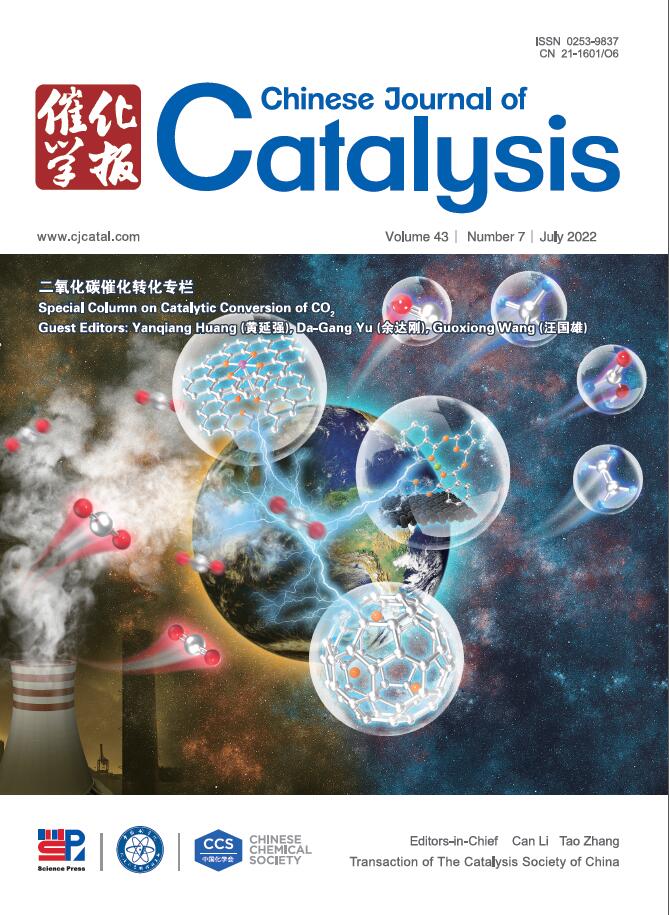Computational insights and strategic choices of nitrate and nitric oxide electroreduction to ammonia
IF 17.7
1区 化学
Q1 CHEMISTRY, APPLIED
引用次数: 0
Abstract
Electrochemical nitrate reduction (eNO3RR) and nitric oxide reduction (eNORR) to ammonia have emerged as promising and sustainable alternatives to the traditional Haber-Bosch method for ammonia production, particularly within the recently proposed reverse artificial nitrogen cycle route: N2 → NOx → NH3. Notably, experimental studies have demonstrated that eNORR exhibits superior performance over eNO3RR on Cu6Sn5 catalysts. However, the fundamental mechanisms underlying this difference remain poorly understood. Herein, we performed systematic theoretical calculations to explore the reaction pathways, electronic structure effects, and potential-dependent Faradic efficiency associated with ammonia production via these two distinct electrochemical pathways (eNORR and eNO3RR) on Cu6Sn5. By implementing an advanced ‘adaptive electric field controlled constant potential (EFC-CP)’ methodology combined with microkinetic modeling, we successfully reproduced the experimental observations and identified the key factors affecting ammonia production in both reaction pathways. It was found that eNORR outperforms eNO3RR because it circumvents the *NO2 dissociation and *NO2 desorption steps, leading to distinct surface coverage of key intermediates between the two pathways. Furthermore, the reaction rates were found to exhibit a pronounced dependence on the surface coverage of *NO in eNORR and *NO2 in eNO3RR. Specifically, the facile desorption of *NO2 on the Cu6Sn5 surface in eNO3RR limits the attainable surface coverage of *NO, thereby impeding its performance. In contrast, the eNORR can maintain a high surface coverage of adsorbed *NO species, contributing to its enhanced ammonia production performance. These fundamental insights provide valuable guidance for the rational design of catalysts and the optimization of reaction routes, facilitating the development of more efficient, sustainable, and scalable techniques for ammonia production.
硝酸和一氧化氮电还原制氨的计算见解和策略选择
电化学硝酸还原(eNO3RR)和一氧化氮还原(eNORR)制氨已成为传统Haber-Bosch制氨方法的有前途和可持续的替代品,特别是最近提出的反向人工氮循环路线:N2→NOx→NH3。值得注意的是,实验研究表明,在Cu6Sn5催化剂上,eNORR表现出优于eNO3RR的性能。然而,这种差异背后的基本机制仍然知之甚少。在此,我们进行了系统的理论计算,以探索通过两种不同的电化学途径(eNORR和eNO3RR)在Cu6Sn5上产生氨的反应途径、电子结构效应和电位依赖的Faradic效率。通过采用先进的“自适应电场控制恒电位(EFC-CP)”方法结合微动力学建模,我们成功地再现了实验观察结果,并确定了两种反应途径中影响氨生成的关键因素。研究发现,eNORR优于eNO3RR,因为它绕过了*NO2解离和*NO2解吸步骤,导致两种途径之间的关键中间体表面覆盖明显。此外,发现反应速率明显依赖于normr中*NO和eNO3RR中*NO2的表面覆盖率。具体来说,eNO3RR中*NO2在Cu6Sn5表面的快速解吸限制了*NO的表面覆盖,从而影响了其性能。相比之下,normr可以保持较高的吸附*NO物种的表面覆盖率,从而提高其产氨性能。这些基本见解为催化剂的合理设计和反应路线的优化提供了有价值的指导,促进了更高效、可持续和可扩展的氨生产技术的发展。
本文章由计算机程序翻译,如有差异,请以英文原文为准。
求助全文
约1分钟内获得全文
求助全文
来源期刊

Chinese Journal of Catalysis
工程技术-工程:化工
CiteScore
25.80
自引率
10.30%
发文量
235
审稿时长
1.2 months
期刊介绍:
The journal covers a broad scope, encompassing new trends in catalysis for applications in energy production, environmental protection, and the preparation of materials, petroleum chemicals, and fine chemicals. It explores the scientific foundation for preparing and activating catalysts of commercial interest, emphasizing representative models.The focus includes spectroscopic methods for structural characterization, especially in situ techniques, as well as new theoretical methods with practical impact in catalysis and catalytic reactions.The journal delves into the relationship between homogeneous and heterogeneous catalysis and includes theoretical studies on the structure and reactivity of catalysts.Additionally, contributions on photocatalysis, biocatalysis, surface science, and catalysis-related chemical kinetics are welcomed.
 求助内容:
求助内容: 应助结果提醒方式:
应助结果提醒方式:


